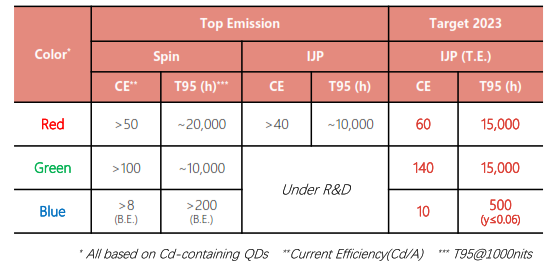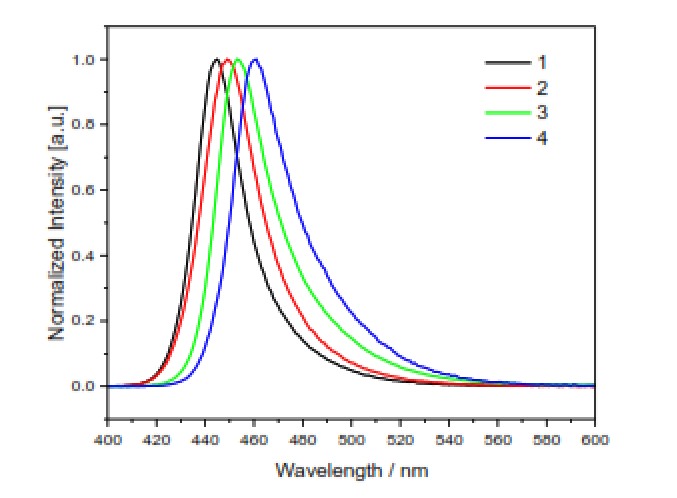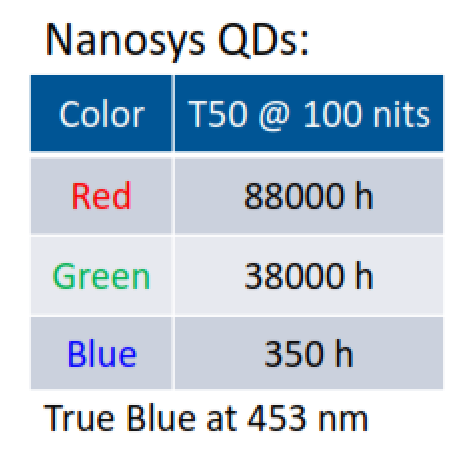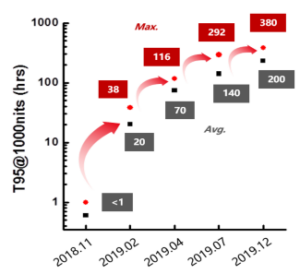That’s another virtual conference in the books. This time it was the OLED Summit. Just like last year, there were a few talks on EL-QLED devices as the OLED community wants to keep tabs on the competition (I suspect).

I had intended on sharing my thoughts on the OLED summit with you earlier, but I felt compelled to share with you last week the news about EL-QLED progress comes out of the “blue.” So now I’ll back track a few weeks to the OLED summit where, on my count, there were two talks focused exclusively on QLED, and QDs were mentioned in a handful of other talks. Since the OLED portion was covered last week I will focus my efforts on the QD highlights.
The two companies in attendance strongly representing EL-QLED technology were Nanosys and TCL. Both are pioneers in the field. Here I’ll try to make sense of all the data presented at the OLED summit, SID Display Week, and recent literature (specifically Samsung’s articles on red and blue Cd-free devices) into an all-encompassing look at the current status of this technology.
TCL
TCL is taking a different approach than many other companies. They have not strayed from their focus on Cd-containing QD devices. It is not surprising that these devices show much better performance than their non-Cd cousins, and TCL leads the way when it comes to lifetime of these devices.
An important distinction here that is very important to call out is the metric used for lifetime. TCL is using T95 at 1000 nits. This is 10x the luminance of the non-Cd devices I recently reported on, and the end point (95% of initial emission) is a far stricter (and more realistic) metric than the T50 which the non-Cd EL-QLEDs are currently reporting. The T95/1000nits value is more akin to what display makers will require of QLED devices, so seeing numbers over 10,000 is very encouraging. As I have mentioned before, red is the closest to being commercially ready, with lifetime of 10-20k hours depending on the method of deposition (according to TCL’s latest results).
 TCL’s current reported metrics for their QLED devices. Source: TCL, OLED Summit 2020
TCL’s current reported metrics for their QLED devices. Source: TCL, OLED Summit 2020
As you can see, the best values are achieved upon spin coating (“spin” in the table above). Spin coating produces extremely thin, uniform layers of QDs which results in better performance. But it is not a viable approach for a large display. Ink jet printing (“IJP” in the table above) is a scalable approach to manufacturing EL-QLED devices, and it is encouraging that the red performance using IJP is approaching the performance of a spin-coated device. It appears that the blue and green IJP results were not worth sharing, so clearly there is work to be done.
TCL shared their own historical progress in blue QLEDs, which as you can see from the graphic below has shown rapid progress in the past 2 years from <1 hour lifetime in 2018, to >300 hours as of late 2019. I presume it’s even higher now.
TCL historical progress on blue Cd-containing EL-QLED device lifetime. Source: TCL, OLED Summit 2020.
Nanosys
Nanosys highlighted their development of blue Cd-free materials development at SID Display Week and the OLED Summit. As of a few weeks ago, I think they probably held the record for lifetime of blue and green Cd-free material. Like Samsung, they are using an alloy of ZnTeSe QD which tends to take on a cubic shape when a shell of ZnSe/ZnS is added. They achieved quite good quantum yield of >80% with a peak width (FWHM) of <30 nm. One salient feature I have noticed in these blue emitter is the presence of significant asymmetry to the emission peak which tails into the green. I wonder how much this could impact the color gamut? Perhaps this is a good topic for another day.
 Emission spectra of an assortment of Nanosys’ blue EL device using ZnTeSe/ZnSe/ZnS cubic QDs. Notice the asymmetry to the longer wavelength side which may impact color gamut. Source: Nanosys, OLED Summit 2020.
Emission spectra of an assortment of Nanosys’ blue EL device using ZnTeSe/ZnSe/ZnS cubic QDs. Notice the asymmetry to the longer wavelength side which may impact color gamut. Source: Nanosys, OLED Summit 2020.
Along with the blue performance, Nanosys shared the progress of their green and red Cd-free device properties, which were quite good. These were reported as T50 values at 100 nits, but still the progress is striking over the past few years when you consider than red and green were at a few hundred hours a couple of years ago. Perhaps the same progress is in store for blue.
 Current lifetime status of Nanosys red, green, and blue Cd-free EL-QLED devices. Source: Nanosys, OLED Summit 2020.
Current lifetime status of Nanosys red, green, and blue Cd-free EL-QLED devices. Source: Nanosys, OLED Summit 2020.
Current status – summarized
For my own sake (and yours) I compiled what I believe to be the current “champion” devices from published literature and conference presentations using the same metrics. Please keep in mind this is a rapidly evolving field, and I have done my best to capture what I believe to be the current state of the art, but it may change quickly. This is not a historical look as is often presented in EL-QLED talks, rather it is the situation today. What follows should help us all understand the performance of each color EL-QLED devices is compared to the others, as well as Cd vs Cd-free, on an equal playing field.
I want everyone to be able to draw their own conclusions from this data, so I have plotted the data two different ways. One with the y-axis formatted to log scale (as is commonly done for these devices) and another as linear scale which highlights the dramatic lifetime differences between Cd-containing and non-Cd devices. I did not find any data for green EL-QLED devices with a metric of T95, 1000 nits, so there is no data in that spot. It is a reasonable assumption that the performance of the green Cd-free devices would fall somewhere between the red (615h) and blue (30h) lifetimes.
 Current status of EL-QLED lifetime including both Cd and non-Cd materials (T95, 1000 nits). The same data is plotted on log scale (left) and linear scale (right) to highlight the differences. Data from multiple published sources including TCL, Nanosys, and Samsung. Current as of October 2020. Click for higher resolution.
Current status of EL-QLED lifetime including both Cd and non-Cd materials (T95, 1000 nits). The same data is plotted on log scale (left) and linear scale (right) to highlight the differences. Data from multiple published sources including TCL, Nanosys, and Samsung. Current as of October 2020. Click for higher resolution.
My takeaways? While there has been excellent progress in lifetime which continues its steady march forward, the general story has not changed much. Two trends in lifetime remain obvious:
- Red > Green >> Blue
- Cd >> Non-Cd
As far as publicly available data goes, it seems Samsung, TCL, and Nanosys are all making excellent progress, with TCL focused on Cd-containing materials, and Samsung/Nanosys focused on non-Cd. It’s an exciting time to be following this field, so I expect I’ll have future updates for you soon! (PP)
Peter Palomaki is the owner and chief scientist at Palomaki Consulting, a firm specializing in helping companies solve big problems at the nanoscale. His utilizes his expertise in quantum dots and materials chemistry to solve challenging problems with clients large and small.

